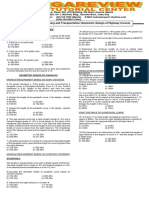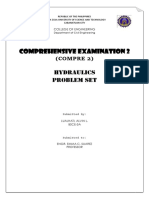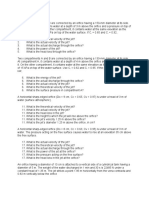Analysis of Signalized Intersections Problem Set
Uploaded by
Ronnel BernabeAnalysis of Signalized Intersections Problem Set
Uploaded by
Ronnel BernabeAnalysis of Signalized Intersections
Problem Set
1. An approach to a pretimed signal has 30 seconds of effective red, and D/D/1 queuing holds. The
total delay at the approach is 83.33 veh-s/cycle and the saturation flow rate is 1000 veh/h. If the
capacity of the approach equals the number of arrivals per cycle, determine the approach flow
rate and cycle length.
2. An approach to a pretimed signal has 25 seconds of effective green in a 60-second cycle. The
approach volume is 500 veh/h and the saturation flow rate is 1400 veh/h. Calculate the average
vehicle delay assuming D/D/1 queuing.
3. An observer notes that an approach to a pretimed signal has a maximum of eight vehicles in a
queue in a given cycle. If the saturation flow rate is 1440 veh/h and the effective red time is 40
seconds, how much time will it take this queue to clear after the start of the effective green
(assuming that approach capacity exceeds arrivals and D/D/1 queuing applies)?
You might also like
- Refresher Module - Surveying and Transportation (Geometric Design of Highway Curves)No ratings yetRefresher Module - Surveying and Transportation (Geometric Design of Highway Curves)1 page
- Answer Evaluation Exam Surveying and Transportation Eng Set A 1 2pdfNo ratings yetAnswer Evaluation Exam Surveying and Transportation Eng Set A 1 2pdf3 pages
- Lecture 7 - Traffic Stream Characterstics - IINo ratings yetLecture 7 - Traffic Stream Characterstics - II15 pages
- Chapter 6 - Traffic Engineering Studies and Traffic Flow CharacteristicsNo ratings yetChapter 6 - Traffic Engineering Studies and Traffic Flow Characteristics14 pages
- Review Innovations: Civil Engineering November 2020 Transportation Engineering 1No ratings yetReview Innovations: Civil Engineering November 2020 Transportation Engineering 12 pages
- Characteristics of The Driver, The Pedestrian, The Vehicle, and The RoadNo ratings yetCharacteristics of The Driver, The Pedestrian, The Vehicle, and The Road96 pages
- Review Module - Transportation EngineeringNo ratings yetReview Module - Transportation Engineering2 pages
- Appendix E: VISSIM Model Calibration Summary: Core of Rosslyn Transportation Study Existing Conditions Report - AppendixNo ratings yetAppendix E: VISSIM Model Calibration Summary: Core of Rosslyn Transportation Study Existing Conditions Report - Appendix41 pages
- Group 7 (Time Scaled Network) Bsce4c - PPTNo ratings yetGroup 7 (Time Scaled Network) Bsce4c - PPT62 pages
- Nov 2024 PB2 - MSTC Kippap Solutions Final100% (1)Nov 2024 PB2 - MSTC Kippap Solutions Final26 pages
- Methods and Structure of The Cebu CordovNo ratings yetMethods and Structure of The Cebu Cordov20 pages
- Business Policy Written Report - Traffic PolicyNo ratings yetBusiness Policy Written Report - Traffic Policy16 pages
- Two Compartments A and B Are Connected by An Orifice Having A 150No ratings yetTwo Compartments A and B Are Connected by An Orifice Having A 1504 pages
- Numerical Methods and Implementation in Geotechnical Engineering – Part 1From EverandNumerical Methods and Implementation in Geotechnical Engineering – Part 1No ratings yet
- Module 6 - Analysis of Signalized IntersectionNo ratings yetModule 6 - Analysis of Signalized Intersection28 pages
- Traffic Control and Analysis at Signalized IntersectionNo ratings yetTraffic Control and Analysis at Signalized Intersection257 pages
- Introduction To Highway and Railway EngineeringNo ratings yetIntroduction To Highway and Railway Engineering19 pages
- Highway Design Data: Engr. Razon C. DomingoNo ratings yetHighway Design Data: Engr. Razon C. Domingo27 pages
































































